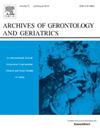Associations of insulin resistance estimated by glucose disposal rate with frailty progression
IF 3.5
3区 医学
Q2 GERIATRICS & GERONTOLOGY
引用次数: 0
Abstract
Objectives
To investigate the relationship between estimated glucose disposal rates (eGDR) and the progression of frailty, using longitudinal data.
Methods
We analyzed four waves of data from the China Health and Retirement Longitudinal Study (CHARLS) from 2011 to 2018, involving 6,778 middle-aged and older adults. eGDR was calculated using a specific formula, categorizing participants into high and low eGDR groups based on the lowest quartile (8.5). Frailty status was assessed using the frailty index (FI). Linear mixed-effects models were employed to analyze the association between eGDR and frailty progression, as well as the impact of transitions in eGDR.
Results
We found that the baseline FI was significantly higher in the low eGDR group compared to the high eGDR group. Furthermore, participants in the low eGDR group exhibited a faster progression of frailty, compared to those in the high eGDR group. Among non-frail participants at baseline, the association between low eGDR and accelerated frailty progression was even more pronounced. Further analysis revealed that, compared to participants who maintained a stable high eGDR, those who transitioned from high to low eGDR and those who consistently remained in the low eGDR group both experienced significantly accelerated frailty progression. On the contrary, participants who transitioned from low to high eGDR did not show a significant acceleration in frailty progression compared to those who consistently maintained a high eGDR.
Conclusion
Low eGDR is linked to accelerated frailty progression in middle-aged and older Chinese adults. Transitioning from low to high eGDR may mitigate this progression, highlighting the importance of eGDR in frailty management.
通过葡萄糖处理率估计胰岛素抵抗与虚弱进展的关系。
目的:利用纵向数据研究估计葡萄糖处置率(eGDR)与衰弱进展之间的关系。方法:我们分析了2011年至2018年中国健康与退休纵向研究(CHARLS)的四波数据,涉及6778名中老年人。使用特定公式计算eGDR,根据最低四分位数(8.5)将参与者分为高和低eGDR组。使用衰弱指数(FI)评估衰弱状态。采用线性混合效应模型分析eGDR与衰弱进展之间的关系,以及eGDR转变的影响。结果:我们发现低eGDR组的基线FI明显高于高eGDR组。此外,与高eGDR组相比,低eGDR组的参与者表现出更快的虚弱进展。在基线时非虚弱的参与者中,低eGDR和加速虚弱进展之间的关联更为明显。进一步的分析显示,与维持稳定的高eGDR的参与者相比,那些从高到低eGDR过渡的参与者和那些一直保持在低eGDR组的参与者都经历了显着加速的虚弱进展。相反,与那些一直保持高eGDR的人相比,从低eGDR过渡到高eGDR的参与者在虚弱进展方面没有明显的加速。结论:在中国中老年人群中,低eGDR与加速衰弱进展有关。从低到高eGDR的过渡可能会减缓这种进展,突出eGDR在虚弱管理中的重要性。
本文章由计算机程序翻译,如有差异,请以英文原文为准。
求助全文
约1分钟内获得全文
求助全文
来源期刊
CiteScore
7.30
自引率
5.00%
发文量
198
审稿时长
16 days
期刊介绍:
Archives of Gerontology and Geriatrics provides a medium for the publication of papers from the fields of experimental gerontology and clinical and social geriatrics. The principal aim of the journal is to facilitate the exchange of information between specialists in these three fields of gerontological research. Experimental papers dealing with the basic mechanisms of aging at molecular, cellular, tissue or organ levels will be published.
Clinical papers will be accepted if they provide sufficiently new information or are of fundamental importance for the knowledge of human aging. Purely descriptive clinical papers will be accepted only if the results permit further interpretation. Papers dealing with anti-aging pharmacological preparations in humans are welcome. Papers on the social aspects of geriatrics will be accepted if they are of general interest regarding the epidemiology of aging and the efficiency and working methods of the social organizations for the health care of the elderly.

 求助内容:
求助内容: 应助结果提醒方式:
应助结果提醒方式:


